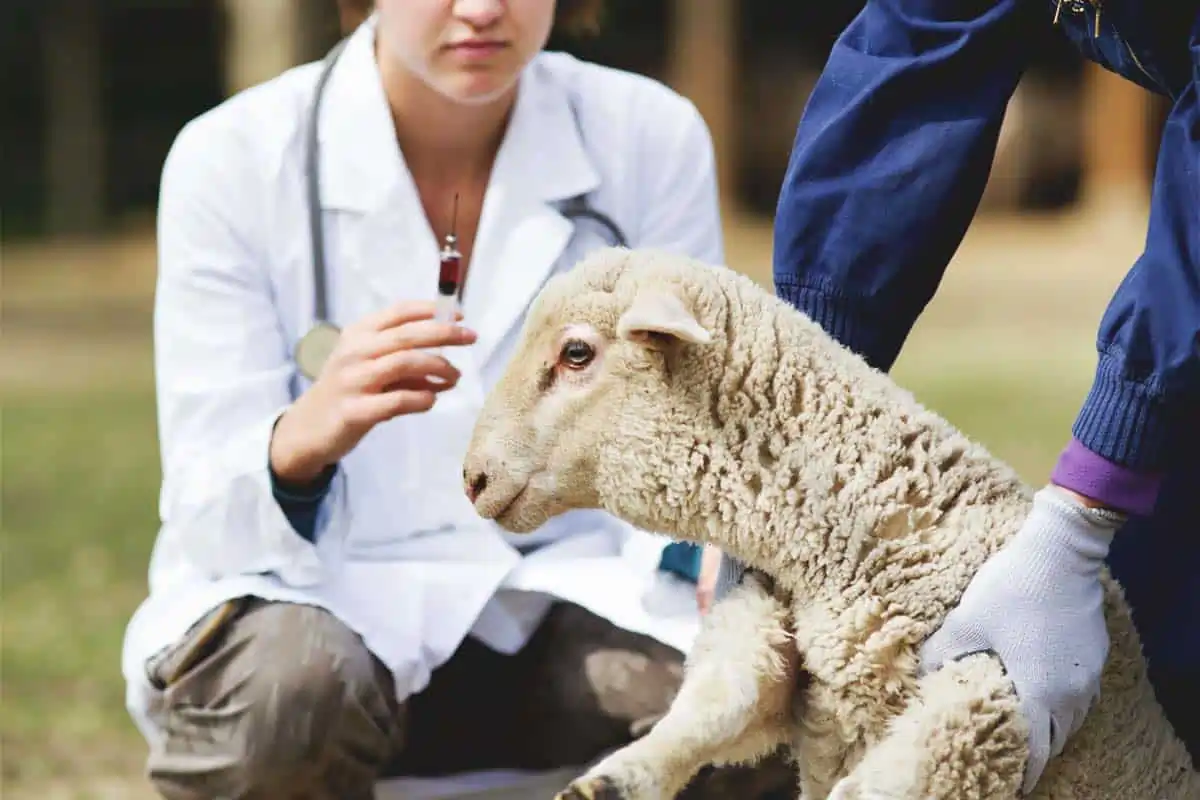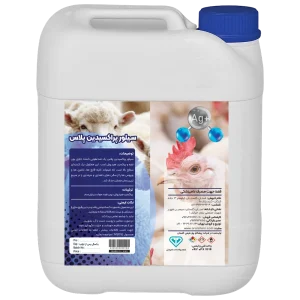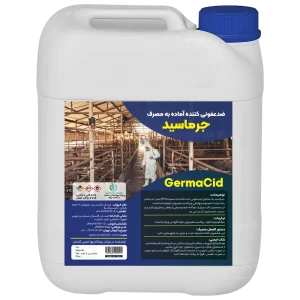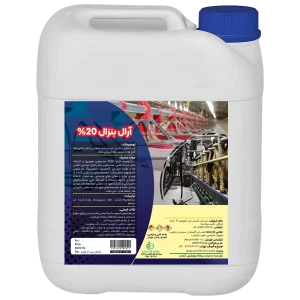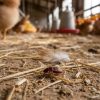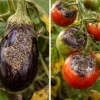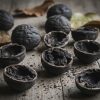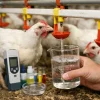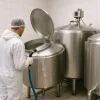بیماری آنتروتوکسمی (پرخوری) و براکسی گوسفند و بز چیست؟

بیماری آنتروتوکسمی و براکسی گوسفند و بز چیست؟
بیماریهای انتروتوکسمی (Enterotoxemia) و براکسی (Braxy) گوسفند و بز از جمله خطرناکترین بیماریهای عفونی هستند که هر دامداری باید آنها را بهخوبی بشناسد. به زبان ساده، براکسی و آنتروتوکسمی که گاهی با نام «بیماری پرخوری» یا «درهمپیچیدگی » شناخته میشود، در اثر سم تولیدشده توسط باکتری کلستریدیوم ایجاد میگردد و میتواند در مدت چند ساعت باعث مرگ ناگهانی دام شود. بر اساس مطالعات جهانی، میزان شیوع باکتریهای عامل در جمعیت دامهای کوچک (گوسفند و بز) در مناطق مختلف دنیا متغیر است، اما گزارشهایی از شیوعی بین ۲۴ تا ۱۰۰ درصد در گلههای آلوده وجود دارد، که نشان میدهد حضور این باکتریها در دامداریها بسیار گستردهتر از آن چیزی است که تصور میشود.
هدف این مقاله، ارائهی یک راهنمای جامع و کاربردی است تا با شناخت دقیق این دو بیماری، راههای پیشگیری، کنترل و درمان اولیه را بهدرستی شناسایی شود. در ادامه، به بررسی نشانهها، علل، راههای انتقال، و نکات کمتر شناختهشده دربارهی انتروتوکسمی و براکسی خواهیم پرداخت تا درک روشنتری از این دو بیماری خطرناک داشته باشید.
همچنین بخوانید:
♣ بیماری تب برفکی دام (FMD) | پیشگیری، کنترل و درمان
♣ آبله گوسفندی و بز | هر آنچه باید درباره آبله در دام بدانید!
بیماری آنتروتوکسمی و براکسی در گوسفند و بز چیست؟
انتروتوکسمی یا ورم روده سمی یا پرخوری، یکی از بیماریهای مرگبار گوسفند و بز است که بر اثر رشد بیشازحد باکتری (کلوستریدیوم پرفرنژنس) در روده و تولید سم ایجاد میشود. این بیماری معمولاً در برهها و بزغالههایی که خوراک پرانرژی مصرف میکنند دیده میشود و باعث مرگ ناگهانی میگردد. براکسی نیز بیماری دیگری است که عامل آن به كلستريديوم سپتيكوم اشاره شده و در هوای سرد و چراگاههای یخزده بروز میکند. سرما به دیوارهی معده آسیب میزند و زمینه را برای عفونت و مرگ سریع دام فراهم میکند. وجه اشتراک آنها این است که، هر دو بیماری بهسرعت پیشرفت میکنند و درمان مؤثری ندارند؛ بنابراین واکسیناسیون و مدیریت تغذیه، بهترین روش پیشگیری از آنهاست.
بیماری انتروتوکسمی و براکسی در گوسفند و بز چه تفاوتی دارند؟
هرچند هر دو بیماری توسط باکتریهای کلوستریدیوم ایجاد میشوند و معمولاً باعث مرگ ناگهانی میگردند، اما از نظر منشاء و سازوکار با هم تفاوت دارند. انتروتوکسمی یا قلوه نرمی دام نتیجهی رشد بیشازحد باکتری در روده و تولید سم ناشی از تغذیه نامتعادل است، در حالی که براکسی در اثر آسیب سرمایی به دیوارهی شیردان و ورود باکتری به بافت رخ میدهد. بهبیان سادهتر، انتروتوکسمی بیماریای تغذیهای و سمی بوده، اما براکسی بیماریای محیطی و ناشی از سرما و یخزدگی میباشد. جدول مقایسه ای بین ویژگی های دو بیماری آنتروتوکسمی و براکسی در گوسفند و بز، به شرح زیر است:
| ویژگی | انتروتوکسمی | براکسی |
|---|---|---|
| عامل بیماریزا | کلوستریدیوم پرفرنژنس (تیپهای C و D) | كلستريديوم سپتيكوم |
| دامهای در معرض خطر | برهها و بزغالههای با تغذیه پرانرژی | گوسفندان چراکننده در هوای سرد و یخزده |
| محل عفونت | روده کوچک و گاهی کبد | شیردان |
| علائم اصلی | مرگ ناگهانی، نفخ، تشنج، اسهال، کلیه نرم در کالبدگشایی | مرگ ناگهانی، تب، بیحالی، تورم شکم، خونریزی در دیوارهی معده |
| سرعت پیشرفت بیماری | بسیار سریع، مرگ ظرف چند ساعت | سریع، مرگ معمولاً طی ۱۲ تا ۲۴ ساعت |
| عوامل خطرساز | پرخوری، تغییر ناگهانی خوراک، استرس، جیره پرغله | هوای سرد، یخبندان، مصرف علوفه یخزده |
| موفقیت درمان | بسیار پایین پس از بروز علائم | بسیار پایین در مراحل بالینی |
| نامهای دیگر | بیماری کلیه نرم / بیماری پرخوری | براکسی یا التهاب سمی شیردان |
رایج ترین علائم آنتروتوکسمی در گوسفند و بز چه هستند؟
بیماری انتروتوکسمی معمولاً بهقدری سریع پیشرفت میکند که دامدار متوجه حضور آن نمیشود تا زمانی که یکی از دامها ناگهان تلف شود. در بسیاری از موارد، حیوانی که تا چند ساعت قبل کاملاً سالم به نظر میرسید، بهطور ناگهانی از بین میرود. سمومی که توسط باکتری كلستريديوم تولید میشوند، در مدت کوتاهی اندامهای داخلی و سیستم عصبی را تخریب و باعث بروز نشانههایی میشوند که گاهی آشکار و گاهی پنهان هستند.
شدت و نوع علائم ممکن است بسته به سن دام، نوع تغذیه و وضعیت عمومی بدن متفاوت باشد. با این حال، شناخت زودهنگام نشانههادر مراحل اولیه یتواند از تلفات بیشتر در گله جلوگیری کند. علائم رایج انتروتوکسمی در گوسفند و بز عبارتاند از:
- مرگ ناگهانی بدون بروز علائم قبلی (شایعترین حالت).
- بیقراری، لرزش بدن، حرکات غیرعادی، یا قرار دادن سر بر روی زمین.
- تغییر در تنفس: تنفس سریع یا بریدهبریده، بهویژه قبل از مرگ.
- اسهال، نفخ شکم و بیتعادلی در حرکت.
- تورم یا کبودی در ناحیهی شکم و اطراف مقعد
- علائم پنهان مانند بیحالی، بیمیلی به چرا و جدا شدن از گله.
علت بیماری آنتروتوکسمی در دام و براکسی چیست؟
دامپزشکان بر این باورند که بیماریهای انتروتوکسمی و براکسی در گوسفند و بز نتیجهی ترکیبی از فعالیت باکتریایی، عدم تعادل تغذیهای و شرایط محیطی نامناسب هستند. باکتریها بهطور طبیعی در دستگاه گوارش دام یا محیط اطراف وجود دارند و در شرایط عادی بیضررند. هنگامیکه تعادل طبیعی گوارش بر هم میخورد یا بافت معده آسیب میبیند، این باکتریها فرصت رشد سریع پیدا کرده و سمومی بسیار قوی تولید میکنند. اما ممکن است عل بروز این بیماریها با توجه به شرایط، متفاوت باشد.
در ادامه، به مهم ترین علل آنتروتوکسمی در دام و براکسی میپردازیم:
الف) ارتباط تغییر ناگهانی جیره غذایی با بروز بیماری
یکی از دلایل اصلی بروز انتروتوکسمی، تغییر ناگهانی در نوع خوراک دام است. زمانی که گوسفند یا بز از چراگاه معمولی به خوراکهای پرانرژی مانند غلات، کنسانتره یا علوفهی تازه منتقل میشود، تعادل میکروبی دستگاه گوارش بهسرعت تغییر میکند. در این شرایط، باکتری کلوستریدیوم پرفرنژنس بهشدت تکثیر شده و سموم خطرناکی تولید میکند که دیواره روده را تخریب کرده و منجر به خونریزی داخلی و مرگ ناگهانی، بهویژه در برهها و بزغالهها، میشود.
در ایران، شیوع این بیماری معمولاً در فصلهای تغییر خوراک، بهویژه در بهار و پاییز بیشتر است؛ یعنی زمانیکه دامها از علوفه خشک به چراگاه تازه یا بالعکس تغییر جیره غذایی میدهند. بنابراین، تغییر تدریجی در جیره نقش کلیدی در پیشگیری از این بیماری دارد.
ب) عوامل محیطی و مدیریتی مؤثر در شیوع بیماری
علاوه بر تغذیه، شرایط مدیریتی و محیطی نیز تأثیر زیادی در بروز این بیماریها دارند. تغذیه دامها در آغلهای آلوده یا کثیف، استفاده از آب راکد یا آلوده و مصرف خوراک فاسد یا کپکزده از عوامل اصلی ایجاد بیماری هستند. چنین محیطهایی زمینهی رشد و انتقال اسپورهای باکتری را فراهم میکنند. از سوی دیگر، تراکم زیاد دام در محیطهای بسته باعث افزایش استرس و انتقال سریعتر بیماری میشود.
همچنین، گرمازدگی، تهویه نامناسب و چرا در مراتع آلوده یا مرطوب میتواند سیستم ایمنی دام را ضعیف کرده و احتمال ابتلا را افزایش دهد. رعایت بهداشت محیط، تأمین خوراک و آب سالم، و جلوگیری از ازدحام دامها از مهمترین اصول مدیریتی برای کنترل این بیماریهاست.
ج) کمبود مواد معدنی خاص مانند سلنیوم و ویتامین E
کمبود این دو ماده باعث تضعیف دیواره روده و کاهش توان سلولها در مقابله با آسیب اکسیداتیو میشود. در نتیجه، سموم باکتریها راحتتر به بافتهای بدن نفوذ میکنند. در برخی پژوهشهای جدید در ایران و ترکیه، رابطه مستقیم بین کمبود سلنیوم و افزایش شیوع انتروتوکسمی گزارش شده است.
د) آلودگی خوراک با سموم قارچی
خوراکهای کپکزده علاوه بر خطر مستقیم، میتوانند سیستم ایمنی و عملکرد روده را مختل کنند، و این موضوع به کلوستریدیوم اجازه رشد و سمسازی بیشتری میدهد. این عامل بهویژه در مناطق مرطوب یا در انبارهای بدون تهویه اهمیت بالایی دارد.
روشهای تشخیص آنتروتوکسمی و براکسی گوسفند بزغاله چگونه است؟
بیماریهای انتروتوکسمی و براکسی در گوسفند و بز، از جمله بیماریهای حاد و کشنده در نشخوارکنندگان کوچک هستند که معمولاً موجب مرگ ناگهانی دامهای ظاهراً سالم میشوند. تشخیص سریع و صحیح این بیماریها در سطح مزرعه و تأیید نهایی توسط دامپزشک نقش مهمی در پیشگیری از تلفات بیشتر دارد. در ادامه، روشهای تشخیص در شرایط مختلف توضیح داده میشود.
1. تشخیص میدانی و شناسایی موارد مشکوک در مزرعه
در مرحله نخست، تشخیص اولیه معمولاً بر اساس علائم مشاهدهشده و شرایط محیطی انجام میگیرد.
- سابقه بیماری و شرایط نگهداری: بروز مرگ ناگهانی در دامهای جوان، چاق یا در حال رشد سریع، بهویژه پس از تغییر جیره یا چرا در مراتع سرسبز، میتواند نشانهای از انتروتوکسمی باشد.
- علائم بالینی پیش از مرگ: در انتروتوکسمی ممکن است دام پیش از مرگ علائمی مانند بیقراری، تشنج، زمین خوردن یا حرکات غیرعادی نشان دهد. در برکسی، علائمی چون تب، افسردگی، درد شکم و بیاشتهایی دیده میشود.
- الگوی همهگیری: در هر دو بیماری، معمولاً چند رأس در فاصله زمانی کوتاه تلف میشوند که میتواند زنگ خطری برای وجود بیماریهای کلستریدیایی باشد.
2. روشهای ساده بررسی لاشه در غیاب امکانات آزمایشگاهی
بررسی دقیق لاشه در صورت عدم دسترسی به آزمایشگاه، میتواند اطلاعات ارزشمندی در اختیار دامدار یا دامپزشک قرار دهد.
در انتروتوکسمی: عامل کلوستریدیوم پرفرنژنس نوع C یا D
- لاشه معمولاً بهسرعت دچار نفخ میشود.
- خونریزیهای نقطهای در زیر پوست، بهویژه اطراف قلب دیده میشود.
- روده کوچک پر از مایع قرمز یا خونآلود است و جدار آن ممکن است متورم و خونریزیدهنده باشد.
در براکسی: عامل كلستريديوم سپتيكوم:
پوست و بافتهای زیرجلدی متورم و پر از گاز هستند (احساس صدای خشخش زیر دست). دیواره شیردان (آبومسوم) دچار التهاب شدید، خونریزی و نکروز میشود. در محل ضایعه معمولاً بوی زننده و خاصی به مشام میرسد که ناشی از گازهای حاصل از فعالیت باکتری است.
3. اهمیت کالبدگشایی و تأیید دامپزشکی
کالبدگشایی دقیق لاشه یکی از ارکان اصلی تشخیص قطعی این بیماریهاست. با بررسی محل و نوع ضایعات (روده در انتروتوکسمی و شیردان در براکسی) میتوان بیماری را از سایر علل مرگ ناگهانی مانند آنتراکس، نفخ یا مسمومیتها تفکیک کرد. برای تأیید نهایی، باید نمونههایی از محتویات روده، شیردان و بافتهای آسیبدیده بهصورت استریل جمعآوری و به آزمایشگاه ارسال شود. در آزمایشگاه، از روشهایی مانند کشت باکتریایی، شناسایی سموم یا تکنیکهای مولکولی PCR جهت تأیید تشخیص استفاده میشود.
روش های پیشگیری از از آنتروتوکسمی و براکسی گوسفند و بز
پیشگیری از آنتروتوکسمی و براکسی دام یکی از موارد مهمی است که هر دامداری باید به آن اهمیت دهد. در این راستا، واکسن آنتروتوکسمی یکی از بهترین راههای پیشگیری خواهد بود. برای پیشگیری، از واکسنهای ۷ یا ۸ گانه کلستریدیایی استفاده کنید. گوسفند و بزهای ماده را ۴ تا ۶ هفته قبل از زایش واکسینه کنید تا برهها و بزغالهها از طریق آغوز ایمن شوند. برهها و بزغالهها در ۶ تا ۸ هفتگی واکسینه شوند و در صورت واکسینه نبودن مادر، در ۲ تا ۳ هفتگی واکسن و ۳ تا ۴ هفته بعد یادآور بگیرند.
در تغذیه، تغییر جیره باید تدریجی باشد و از پرخوری ناگهانی جلوگیری شود. علوفه را قبل از کنسانتره بدهید و آب تمیز در اختیار دام باشد. جایگاه را تمیز نگه دارید، از تراکم زیاد پرهیز کنید و لاشهها را دفن یا بسوزانید. استفاده از آهک در زمینهای آلوده نیز مفید است.
روش های درمانی بیماری پرخوری یا آنتروتوکسمی در دام چیست؟
درمان بیماری پرخوری یا آنتروتوکسمی در دام باید در سریعترین زمان ممکن آغاز گردد، زیرا در بیشتر موارد پیشرفت بیماری بسیار سریع است و تأخیر در درمان میتواند منجر به مرگ دام شود.
در ادامه، مهمترین اقدامات درمانی در مواجهه با دامهای مبتلا یا مشکوک به آنتروتوکسمی آورده شده است:
اقدامات فوری در زمان مشاهده علائم
در مراحل اولیه بروز علائم، سرعت عمل اهمیت زیادی دارد. اقدامات زیر باید بلافاصله انجام گیرد:
- جداسازی سریع دام بیمار از سایر دامها برای کاهش استرس و جلوگیری از آسیب بیشتر.
- تماس فوری با دامپزشک جهت تأیید تشخیص و آغاز درمان اختصاصی.
- قطع موقت خوراکهای غنی از انرژی مانند غلات و کنسانتره تا زمان بهبود کامل.
- در صورت امکان، استفاده از خوراکهای زودهضم و کمنشاسته برای کاهش تخمیر و فشار بر روده.
استفاده از سرم ضد سم (Antitoxin)
درمان اصلی و مؤثرترین روش مقابله با آنتروتوکسمی، استفاده از سرم آنتیتوکسین کلستریدیوم نوع C و D است.
- تزریق این سرم در مراحل اولیه میتواند سموم تولیدشده توسط باکتری را خنثی کرده و از پیشرفت آسیب جلوگیری کند.
- مقدار و روش تزریق باید طبق دستور دامپزشک معمولاً بهصورت عضلانی یا زیرجلدی انجام شود.
- در مواردی که سرم در دسترس نیست، میتوان تا زمان تهیه آن از درمان حمایتی مانند مایعات، آنتیبیوتیک، ویتامینها برای حفظ حیات دام استفاده کرد.
درمان دارویی و حمایتی
در کنار استفاده از آنتیتوکسین، درمانهای دارویی و حمایتی نقش مهمی در بهبود دام دارند:
- آنتیبیوتیکها: با تجویز دامپزشک جهت کنترل رشد باکتریهای کلستریدیایی (معمولاً پنیسیلین یا تتراسایکلین).
- تزریق مایعات و الکترولیتها: برای جبران کمآبی، جلوگیری از شوک و بهبود جریان خون.
- ویتامینهای گروه B و پروبیوتیکها: بهمنظور تقویت عملکرد سیستم گوارشی و کمک به بازسازی فلور مفید روده.
- تنظیم تغذیه: پس از بهبود نسبی، تغذیه باید تدریجاً و با خوراک کمنشاسته آغاز گردد تا از عود بیماری پیشگیری شود.
کلام آخر:
آنتروتوکسمی و براکسی در گوسفند و بز بیماریهای بسیار خطرناک و سریعالانتشار هستند که میتوانند باعث مرگ ناگهانی دام شوند. واکسیناسیون منظم دامهای ماده و برهها/بزغالهها، تغییر تدریجی جیره غذایی، رعایت بهداشت محیط و مدیریت صحیح تغذیه مهمترین راههای پیشگیری هستند. یکی از روش های پیشگیرانه از شیوع بیماری آنتروتوکسمی و براکسی، ضدعفونی سطوح و سالن های پرورش با ضدعفونی کننده های سطح بالای صنایع آرال شیمی همچون داموسیب و آرال گلوتار است. همچنین کلیه ابزار را می توان با محصول سیلور پراکسیدین پلاس و جرماسید، گندزدایی کرد تا از پاکیزگی کامل، اطمینان حاصل شود.
-
سیلور پراکسیدین پلاس
محدوده قیمت: 2185000تومان تا 4250000تومان انتخاب گزینهها این محصول دارای انواع مختلفی می باشد. گزینه ها ممکن است در صفحه محصول انتخاب شوند -
داموسیب | پراستیک اسید 5 درصد
محدوده قیمت: 1125000تومان تا 2180000تومان انتخاب گزینهها این محصول دارای انواع مختلفی می باشد. گزینه ها ممکن است در صفحه محصول انتخاب شوند -
جرماسید | ضدعفونی کننده آماده بمصرف
محدوده قیمت: 325000تومان تا 1100000تومان انتخاب گزینهها این محصول دارای انواع مختلفی می باشد. گزینه ها ممکن است در صفحه محصول انتخاب شوند -
آرال بنزال | بنزآلکونیوم کلراید 20% دام و طیور
محدوده قیمت: 1725000تومان تا 6601000تومان انتخاب گزینهها این محصول دارای انواع مختلفی می باشد. گزینه ها ممکن است در صفحه محصول انتخاب شوند


